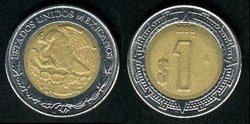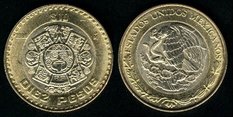Mexican peso
|
|
The peso is the currency of Mexico. The symbol used for the peso is "$", while the 100 centavos into which it is divided are represented by "¢". The current ISO 4217 code for the Mexican peso is MXN; prior to the 1993 revaluation (see below), the code "MXP" was used.
| Contents |
History
The peso was originally based on imperial Spain's silver dollars, the renowned pieces of eight of pirate literature and Hollywood swashbucklers.
The name peso means weight, and this is a reference to the principal characteristic of the coin. During colonial times, the silver mines of Mexico supplied ample sources of pure silver and, more importantly, the peso was the first coin to have a border that made it easy to detect if the coin had been tampered with. It was a common practice to cut or wear down the edges of gold and silver coins, thus obtaining raw precious metal. Since the peso was a coin of pure silver with an exact weight, it became very popular: Mexican pesos could be found in China and the Philippines.
After a decree adopted by the United States on 6 July 1785, the peso became the official system of all North America; it also became the foundation for the U.S. monetary system, at a rate of one peso to one dollar. The US dollar was not issued until 2 April 1792, but the peso continued to be officially recognised and used until 21 February 1857. In Canada, it remained a legal medium of payment until 1858.
Current system
Throughout most of the 20th century, the Mexican peso remained one of the most stable currencies in Latin America, since the economy did not experience periods of hyperinflation common to other countries in the region. However, after the Oil Crisis of the late 1970s, Mexico defaulted on its external debt in 1982, and experienced several years of inflation and devaluation until a government economic strategy called the "Stability and Economic Growth Pact" (Pacto de estabilidad y crecimiento económico, PECE) was adopted under President Carlos Salinas. On 1 January 1993, the Bank of Mexico introduced a new currency, the nuevo peso ("new peso", or MXN), written "N$" followed by the numerical amount. One new peso, or N$1.00, was equal to 1,000 of the obsolete MXP pesos.
On 1 January 1996, the modifier nuevo was dropped from the name and new coins and banknotes – identical in every respect to the 1993 issue, with the exception of the now absent word "nuevo" – were put into circulation. The ISO 4217 code, however, remained unchanged as MXN.
Nowadays, due to the stability of the Mexican economy, and the growth in foreign investment, the Mexican peso is among the 15 most traded currency units in the world, and the most traded in Latin America. It has been fairly stable for the last few years; since the late 1990's the peso has traded about 10 to 1 versus the U.S. dollar, and is currently about MX$10.8 per dollar. This makes it relatively easy to mentally convert from dollars to pesos and back; the 50¢ coin is worth about the same as a U.S. nickel, and a 200 peso note about US$20.
Coins
The coins commonly encountered in circulation have face values of 10¢, 20¢, 50¢, $1, $2, $5, $10, and $20. A $50 coin also exists and is legal tender, but it was not included in the 1996 issue; it is extremely rare and largely disliked by users. The $20 coin is slightly less rare, but disliked just as intensely. Coins worth 5¢ were also introduced at the changeover; they are now rare, however, and might even have been withdrawn from circulation. All the coins incorporate design elements from the Aztec Calendar.
(The $50 coin must be distinguished from the Mexican gold bullion 50-peso coin, which contains 37.5 grams (1.2067 troy ounces) of pure gold and, of course, does not circulate at face value.)
In 2004 the Bank of Mexico began the gradual launch of a new series of bimetallic $100 coins. These number 32 – one for each of the nation's 31 states, plus the Federal District. While the reverse of these coins bears the traditional Mexican coat of arms, their obverses show the individual coats of arms of the component states. The first states to be celebrated in this fashion were Tabasco, Tamaulipas, San Luis Potosí, Sinaloa, and Sonora. In circulation they are extraordinarily rare, but their novelty value counterbalances the unease most users feel at having such a large amount of money in a single coin. Although the Bank has tried to encourage users to collect full sets of these coins, issuing special display folders for the purpose, the high cost involved has worked against them. Bullion versions of these coins are also available, with the outer ring made of gold, instead of a bronze/aluminium alloy.
|






